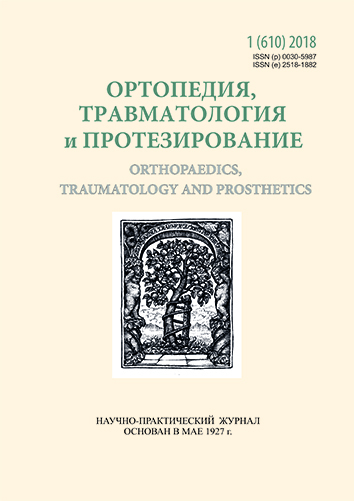The results of conservative treatment and short transpedicular fixation at burst fractures of thoracic and lumbar spine
DOI:
https://doi.org/10.15674/0030-59872018119-28Keywords:
burst fracture, posterior transpedicular fixation, fusion, orthesisAbstract
Multifragmentary (burst) fracture can happen in case of spine trauma under the influence of high-energy axial compression with penetration of bone fragments into spine canal and paravertebral tissues.
Objective: to analyze the results of treatment of patients with burst thoracic and lumbar spine fractures who were treated by conservative therapy and surgery with short transpedicular fixation.
Methods: we made retrospective analysis of 23 patients with incomplete burst fractures type A3.1 and burst split fractures type 3.2 of thoracic and lumbar spine without neurological deficiency. Patients were divided into two groups: group A (conservative treatment) and group B (surgical treatment with short transpedicular fixation). We made assessment of pain, value of kyphotic deformity, compression degree, spine canal stenosis and index of sagital balance.
Results: conservative treatment is indicated for patients with burst fractures type A3.1 without neurological symptoms, spine canal stenosis (up to 10 %) and posterior ligaments damage. Method of posterior fusion with short transpedicular fixation can be recommended for the treatment of incomplete burst fractures type A3.1 and A3.2 without neurological symptoms, with reserved pedicles and fragmentation of vertebrae up to 50 % of its square. Short six screws fixation can provide incomplete deformity correction (to 5 %), stable fixation with minimal loss of correction.
Conclusions: conservative and surgical methods of treatment can provide satisfactory clinical results. But X-rays analysis showed advantages of surgical treatment.
References
- Ramich, E. A. (1975). Reparative regeneration of fractures of vertebral bodies. (clinical and experimental substantiation (Doctoral dissertation). Moscow. (in Russian)
- Aebi, M., Arlet, V., & Webb, J. (2007). AO Spine manual principles and techniques. Thieme, 1, 663.
- Aebi, M., Arlet, V., & Webb, J. (2007). AO Spine manual principles and techniques. Thieme, 2, 837.
- Dai, L., Jiang, L., & Jiang, S. (2008). Conservative treatment of thoracolumbar burst fractures. Spine, 33(23), 2536-2544. doi: https://doi.org/10.1002/jbm.a.34741
- Joaquim, A. F., Fernandes, Y. B., Cavalcante, R. A., Fragoso, R. M., Honorato, D. C., & Patel, A. A. (2011). Evaluation of the thoracolumbar injury classification system in thoracic and lumbar spinal trauma. Spine, 36(1), 33-36. doi: https://doi.org/10.1097/brs.0b013e3181c95047
- Vaccaro, A. R., Rihn, J. A., Saravanja, D., Anderson, D. G., Hilibrand, A. S., Albert, T. J., … Fisher, C. (2009). Injury of the posterior ligamentous complex of the thoracolumbar spine. Spine, 34(23), E841-E847. doi: https://doi.org/10.1097/brs.0b013e3181bd11be
- Jackson, R. P., & McManus, A. C. (1994). Radiographic analysis of sagittal plane alignment and balance in standing volunteers and patients with low back pain matched for age, sex, and size. Spine, 19(Supplement), 1611-1618. doi: https://doi.org/10.1097/00007632-199407001-00010
- Keynan, O., Fisher, C. G., Vaccaro, A., Fehlings, M. G., Oner, F. C., Dietz, J., … Dvorak, M. (2006). Radiographic measurement parameters in thoracolumbar fractures: a systematic review and consensus statement of the spine trauma study group. Spine, 31(5), E156-E165. doi: https://doi.org/10.1097/01.brs.0000201261.94907.0d
- Schwab, F., Ungar, B., Blondel, B., Buchowski, J., Coe, J., Deinlein, D., … Lafage, V. (2012). Scoliosis research society—schwab adult spinal deformity classification. Spine, 37(12), 1077-1082. doi: https://doi.org/10.1097/brs.0b013e31823e15e2
- Altay, M., Ozkurt, B., Aktekin, C. N., Ozturk, A. M., Dogan, Ö., & Tabak, A. Y. (2007). Treatment of unstable thoracolumbar junction burst fractures with short- or long-segment posterior fixation in magerl type a fractures. European Spine Journal, 16(8), 1145-1155. doi: https://doi.org/10.1007/s00586-007-0310-5
Downloads
How to Cite
Issue
Section
License
Copyright (c) 2018 Volodymyr Radchenko, Konstantin Popsuishapka, Dmytro Chekryzhev, Sergii Teslenko

This work is licensed under a Creative Commons Attribution 4.0 International License.
The authors retain the right of authorship of their manuscript and pass the journal the right of the first publication of this article, which automatically become available from the date of publication under the terms of Creative Commons Attribution License, which allows others to freely distribute the published manuscript with mandatory linking to authors of the original research and the first publication of this one in this journal.
Authors have the right to enter into a separate supplemental agreement on the additional non-exclusive distribution of manuscript in the form in which it was published by the journal (i.e. to put work in electronic storage of an institution or publish as a part of the book) while maintaining the reference to the first publication of the manuscript in this journal.
The editorial policy of the journal allows authors and encourages manuscript accommodation online (i.e. in storage of an institution or on the personal websites) as before submission of the manuscript to the editorial office, and during its editorial processing because it contributes to productive scientific discussion and positively affects the efficiency and dynamics of the published manuscript citation (see The Effect of Open Access).














